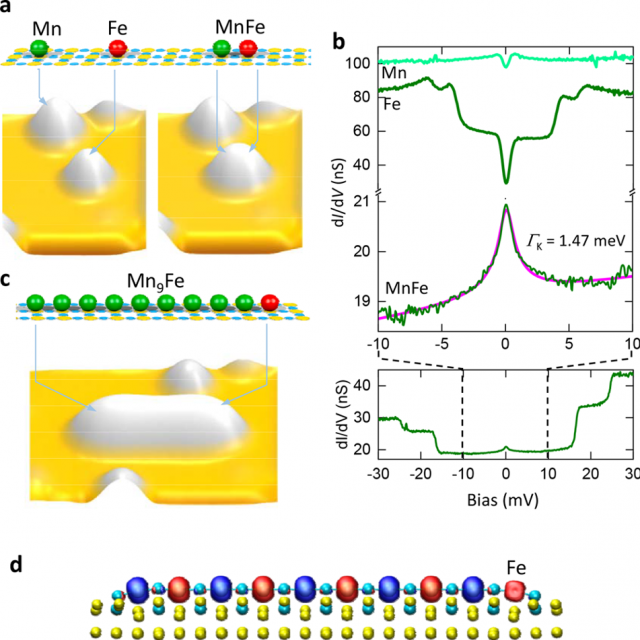A Kondo effect by manipulating spin chains

The scattering of conduction electrons in metals owing to impurities with magnetic moments is known as the Kondo effect, after Jun Kondo, who analysed the phenomenon in 1964. This scattering increases the electrical resistance and has the consequence that, in contrast to ordinary metals, the resistance reaches a minimum as the temperature is lowered and then increases as the temperature is lowered further.
The Kondo effect is a collective one involving an indirect exchange interaction of the conduction electrons with a paramagnetic impurity. In paramagnetism, atoms or molecules have net orbital or spin magnetic moments.
Actually, conduction electrons scattering off a magnetic impurity can screen the localized magnetic moment by forming a nonmagnetic many-particle singlet state. On a metallic surface, this Kondo screening manifests itself as a prominent zero-bias resonance in scanning tunneling microscope (STM) differential conductance measurements.
Still, a fully quantitative description of the Kondo effect is a very difficult many-body-problem. Even if ample experimental evidence exists for Kondo resonances of single spins on metals, either atomic or molecular, an entirely different world is revealed when several spins interact on metallic hosts. An extensive body of theoretical work explores the rich range of new states of matter that can be created from the competition of Kondo screening and interspin interactions. These phenomena exhibit extraordinary complexity but offer great potential if the emergent quantum states could be controlled.
The Kondo effect in spin-coupled chains has been proposed as a means of transmitting quantum coherent information in solid-state environments. This concept requires ways to extend and manipulate the Kondo effect on the atomic level. To date, in most scenarios considered experimentally, each spin is individually Kondo-screened, and the interaction among spins drives the preexisting Kondo effect into a new phase of matter.
But, what if we could create emergent Kondo states in nanostructure systems built from atoms that, individually, are not Kondo screened? Now a team of researchers, with the participation of Nicolás Lorente from CFM and DIPC, has created 1 spin chains in which a strongly correlated Kondo state emerges from magnetic coupling of transition-metal atoms. The researchers built these linear chains – up to ten atoms in length – by placing iron (Fe) and manganese (Mn) atoms on a monolayer film of copper nitride (Cu2N) with a STM.

They found that chains with one Fe and an odd number of Mn atoms exhibit a collective Kondo state. The emergent Kondo resonance is spatially distributed along the chain. Its strength can be controlled by mixing atoms of the metal elements and manipulating their spatial distribution.
The Kondo state in the composite system appears only if the spin−spin interactions within the chain are engineered to entangle all atomic spins with each other and form a doubly degenerate ground state that enables electrons from the host metal to flip all spins in the chain by a single electron scattering event.
The atomically precise construction allows the exact determination of the chain composition and the tuning of the coupling strengths. These determine the degree of interatomic entanglement which influences the probability of a spin-flip scattering and the resulting efficiency of the Kondo screening. In other words, the control the researchers achieve over the atomic entanglement in the chain means they control the emergence of a many-body electronic state.
The results demonstrate that it is experimentally feasible to create a Kondo ground state within a chain of atoms with large magnetic moments. The emergent Kondo state can be tuned by a competition between interatomic spin interaction and magneto-crystalline anisotropy of the constituent atoms.
The Kondo state, the researchers conclude, depends on the specific atomic composition of the spin chain and is characterized by the degree of entanglement among the atoms of the chain. This indicates that surface-adsorbed spin chains can serve as prototype systems for the exploration of correlated condensed-matter phases, where the electron correlations are tailored by the specific design of the atomic chains.
The method developed can in principle be generalized to a broader class of materials where electron−electron interaction can be tuned by structure and composition.
Author: César Tomé López is a science writer and the editor of Mapping Ignorance.
References
- Deung-Jang Choi, Roberto Robles, Shichao Yan, Jacob A. J. Burgess, Steffen Rolf-Pissarczyk, Jean-Pierre Gauyacq, Nicolás Lorente, Markus Ternes, and Sebastian Loth (2017) Building Complex Kondo Impurities by Manipulating Entangled Spin Chains Nano Letters doi: 10.1021/acs.nanolett.7b02882 ↩